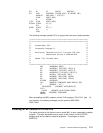
ITS2: CPYNV RESULT,ARG2;
The program has now finished processing and ends:
RETURN: RTX ᑍ;
PEND;
The previous return external (RTX) instruction is not needed because it is implied
by the PEND directive. The RTX instruction is included to add clarity to the
program flow.
MI01 Program—Complete Code Example
Put all together, the program looks like this:
/ᑍᑍᑍᑍᑍᑍᑍᑍᑍᑍᑍᑍᑍᑍᑍᑍᑍᑍᑍᑍᑍᑍᑍᑍᑍᑍᑍᑍᑍᑍᑍᑍᑍᑍᑍᑍᑍᑍᑍᑍᑍᑍᑍᑍᑍᑍᑍᑍᑍᑍᑍᑍᑍᑍᑍᑍᑍᑍᑍᑍᑍᑍᑍᑍᑍᑍᑍᑍ/
/ᑍᑍᑍᑍᑍᑍᑍᑍᑍᑍᑍᑍᑍᑍᑍᑍᑍᑍᑍᑍᑍᑍᑍᑍᑍᑍᑍᑍᑍᑍᑍᑍᑍᑍᑍᑍᑍᑍᑍᑍᑍᑍᑍᑍᑍᑍᑍᑍᑍᑍᑍᑍᑍᑍᑍᑍᑍᑍᑍᑍᑍᑍᑍᑍᑍᑍᑍᑍ/
/ᑍ ᑍ/
/ᑍ Program Name: MI1 ᑍ/
/ᑍ ᑍ/
/ᑍ Programming Language: MI ᑍ/
/ᑍ ᑍ/
/ᑍ Description: Return the larger of two packed arguments. ᑍ/
/ᑍ ᑍ/
/ᑍ ᑍ/
/ᑍ Header Files Included: None ᑍ/
/ᑍ ᑍ/
/ᑍ ᑍ/
/ᑍᑍᑍᑍᑍᑍᑍᑍᑍᑍᑍᑍᑍᑍᑍᑍᑍᑍᑍᑍᑍᑍᑍᑍᑍᑍᑍᑍᑍᑍᑍᑍᑍᑍᑍᑍᑍᑍᑍᑍᑍᑍᑍᑍᑍᑍᑍᑍᑍᑍᑍᑍᑍᑍᑍᑍᑍᑍᑍᑍᑍᑍᑍᑍᑍᑍᑍᑍ/
ENTRY ᑍ (PARM_LIST) EXT;
DCL SPCPTR ARG1@ PARM;
DCL SPCPTR ARG2@ PARM;
DCL SPCPTR RESULT@ PARM;
DCL OL PARM_LIST
(ARG1@,
ARG2@,
RESULT@)
PARM EXT;
DCL DD ARG1 PKD(15,5) BAS(ARG1@);
DCL DD ARG2 PKD(15,5) BAS(ARG2@);
DCL DD RESULT PKD(15,5) BAS(RESULT@);
CMPNV(B) ARG1,ARG2 / LO(ITS2);
CPYNV RESULT,ARG1;
B RETURN;
ITS2: CPYNV RESULT,ARG2;
RETURN: RTX ᑍ;
PEND;
Compiling a Program
If you enter the source into a source physical file, you can now compile the source
and create an MI program. To create the program, use the Create Program
(QPRCRTPG) API documented in the
System API Reference
.
Note: The QPRCRTPG API assumes that the source statements presented to it
are in code page 37. See the introduction to the
Machine Interface Func-
tional Reference
for the specific code points required to build MI programs.
7-4 System API Programming V4R1


















